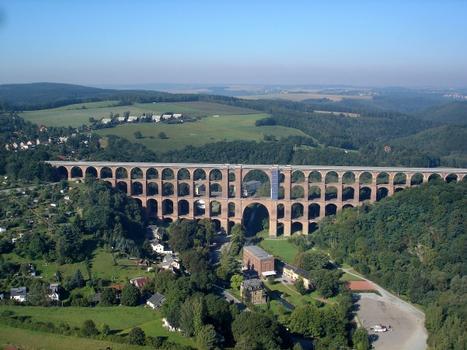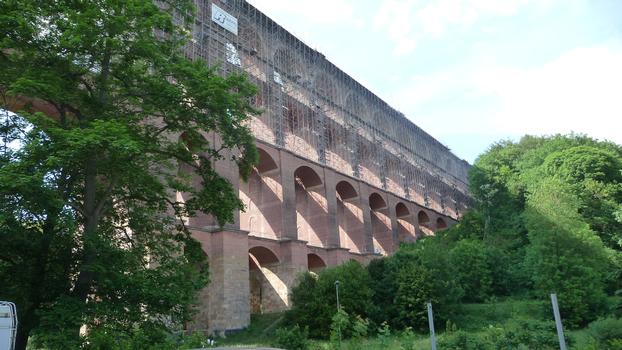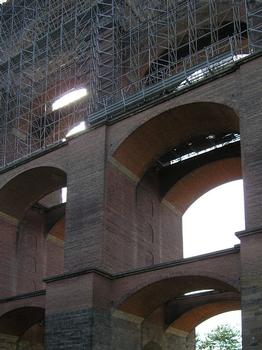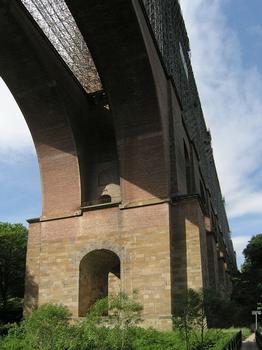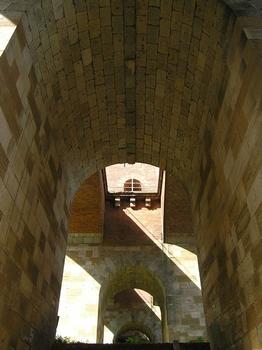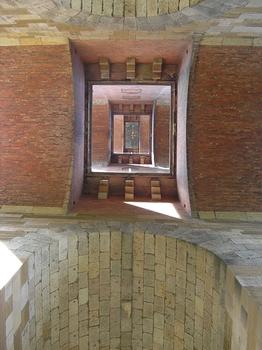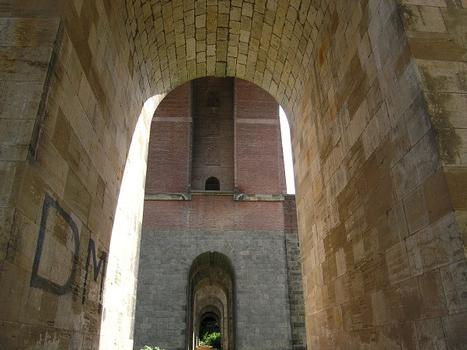General Information
Project Type
| Structure: |
Four-story semi-circular arch bridge |
|---|---|
| Function / usage: |
Railroad (railway) bridge |
| Material: |
Masonry bridge |
| Structure: |
main arch: Two-story semi-circular arch bridge |
Awards and Distinctions
| 2009 |
for registered users |
|---|
Location
| Location: |
Netzschkau, Vogtlandkreis, Saxony, Germany |
|---|---|
| Coordinates: | 50° 37' 21.02" N 12° 14' 38.24" E |
Technical Information
Dimensions
| length of side spans | 14 m | |
| height | 78 m | |
| total length | 578 m | |
| longest span | 30.9 m |
Materials
| arches |
masonry
|
|---|
Excerpt from Wikipedia
The Göltzsch Viaduct (German: Göltzschtalbrücke) is a railway bridge in Germany. It is the largest brick-built bridge in the world, and for a time it was the tallest railway bridge in the world. It spans the valley of the Göltzsch River between Mylau and Netzschkau, around 4 kilometres (2.5 mi) west of Reichenbach im Vogtland in the German Free State of Saxony.
It was built between 1846 and 1851 as part of the railway between Saxony (Leipzig, Zwickau, and Plauen) and Bavaria (Hof and Nuremberg). It is currently part of the Leipzig–Hof line, near the Netzschkau station. About 10 kilometres (6.2 mi) south, the smaller Elster Viaduct was built for the same line and is quite similar to the Göltzsch Viaduct.
Göltzsch Viaduct is also the name of a much smaller viaduct built in 1938 where Bundesautobahn 72 crosses the Göltzsch River. It sits about 10 km (6 mi) due southeast near the village of Weissensand.
Göltzsch Viaduct (previously Mylau Central Station) was also the name of a terminus opened in 1895 on the Reichenbach–Göltzsch Viaduct railway in the Göltzsch valley below the railway bridge. From here, trains departed to the central station of Reichenbach im Vogtland and to Lengenfeld.
History and construction
One of the greatest challenges in constructing a railway between Saxony and Bavaria was how to bridge the Göltzsch valley. Hoping to find a financially feasible construction plan, the Saxon-Bavarian Railway Company announced a contest on 27 January 1845 in all major German magazines with prize money of 1000 Thalers. However, none of the 81 submissions could prove by means of structural analysis that it would be able to withstand the stresses of rail traffic on the bridge. The prize money was eventually divided among four contestants, but none of their designs were actually realized.
The chairman of the jury, professor Johann Andreas Schubert subsequently designed a bridge himself, making use of his recently attained knowledge of structural analysis, and letting himself be inspired by the submitted designs and the viaduct in Leubnitz (Werdau), which was finished in the summer of 1845, making it the first bridge in the world to be subjected to a full structural analysis. It was planned to build the bridge mainly out of bricks, at the time a highly unusual choice, because of the abundance of loam in the vicinity, which allowed for rapid and cost-efficient production of bricks. Granite was to be used only for certain crucial segments.
The first stone was laid on 31 May 1846. The plans were revised just once after construction began, when certain technical difficulties arose. For instance, the foundation on which the bridge was to be built turned out to be less firm than previously assumed. Chief engineer Robert Wilke solved this by replacing the arches in the middle with one great central arch, which only added to the impressiveness of this edifice.
The Göltzsch Viaduct was an extraordinarily large endeavor for its time. Each day, the nearly 20 brickyards along the railway line would produce 50,000 bricks with the unusual dimensions of 28×14×6.5 centimetres (11.0×5.5×2.6 in). The scaffolding was custom-made for each arch, totalling 23,000 tree trunks, although other sources even speak of 230,000 trunks. In total, 1,736 construction workers built the bridge, with 31 on-site fatalities. When the bridge was completed and inaugurated on 15 July 1851, it was world's tallest railway bridge. Today, it still holds the record for largest brick bridge in the world.
Key people
- Professor Johann Andreas Schubert (1808–1870) – Chairman of the jury, architect, structural analyst
- Chief engineer Robert Wilke (1804–1889) – Construction planner and chief superintendent
- Engineer Ferdinand Dost (1810–1888) – Superintendent
- Pharmacist and chemist Heinrich Carl – Mortar composition
Recent history
A museum in the nearby Mylau Castle opened in 1883 that has dedicated a room to the Göltzsch Viaduct, that among others includes a scale model of the scaffolding, copies of the original building plans, a three-dimensional height map of the region, and photographs and paintings made during the bridge's construction.
In 1930, a top layer of reinforced concrete with a parapet allowed the railway track to become wider.
During the latter days of World War II, the Wehrmacht intended to blow up the bridge with explosives. This plan was never executed.
Between 1955 and 1958, the masonry was completely restored. It would take until 1977 for all work, including smaller jobs such as the placement of steel cover plates, to be completed.
The Göltzsch Viaduct is part of the so-called Saxon-Franconian trunk line (Sachsen-Franken-Magistrale), which was restored from 1997 through to 2000. This allows tilting trains to use this trajectory, which can reach speeds of up to 160 kilometres per hour (99 mph) even on curved tracks.
Around the bridge, many walking paths allow a good impression of the actual magnitude of this masterpiece of engineering. It is also possible to see the bridge and its surroundings from an altitude of 150 metres (490 ft) with a helium balloon situated near the bridge.
The bridge is infamous for its reputation as a suicide bridge, as many have taken their lives by plunging off the bridge over the past 150 years. In August 2001, three teenagers from Reichenbach im Vogtland jumped off. The 2002 documentary film Ein Tag mit Folgen: Teuflische Spiele (A Day with Consequences: Diabolical Games) pictures the lives of the families and friends that stayed behind, and their attempts to get to terms with the events. After 8 suicides in just 8 months in 2002, the Federal Police increased supervision.
Between 2006 and 2008, Deutsche Bahn invested 2.2 million Euro in a new elevator system for maintenance work on the bridge.
In June 2009, the German engineers' guild declared the Göltzsch Viaduct along with the Fernsehturm Stuttgart as historical milestone of engineering. This title was previously awarded in 2007 to the Niederfinow boat lift.
From mid-2010 to early 2012, only one track could be used at one time for rail transport, due to the electrification of the track between Reichenbach im Vogtland and Hof. The top of the bridge was replaced by reinforced concrete, which supports the 22 masts that carry the overhead lines.
Text imported from Wikipedia article "Göltzsch Viaduct" and modified on July 22, 2019 according to the CC-BY-SA 4.0 International license.
Participants
- Robert Wilke (engineer)
- Johann Andreas Schubert (engineer)
- Klaus Baumann (checking engineer)
Relevant Web Sites
Relevant Publications
- (2001): 150 Jahre Göltzschtal- und Elstertalbrücke. In: Bautechnik, v. 78, n. 7 (July 2001), pp. 524-526.
- (2002): Bridges that Changed the World. Prestel, Munich (Germany), pp. 68-69.
- (1956): Brücken. Karl Robert Langewiesche Verlag, Königstein im Taunus (Germany), pp. 67.
- (1994): Brücken / Bridges. Ästhetik und Gestaltung / Aesthetics and Design. 4th edition, Deutsche Verlags-Anstalt, Stuttgart (Germany), pp. 87-88.
- (1997): Brücken am Weg. Frühe Brücken aus Eisen und Beton in Deutschland und Frankreich. Wilhelm Ernst & Sohn Verlag für Architektur und technische Wissenschaften GmbH, Berlin (Germany), ISBN 978-3-433-01299-4, pp. 51-53.
- About this
data sheet - Structure-ID
20000639 - Published on:
25/03/2000 - Last updated on:
24/06/2022

